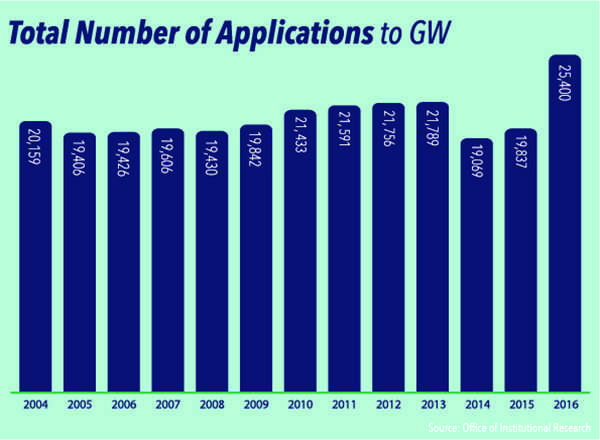Updated: Feb. 13, 2016 at 2:21 p.m.
Officials say GW’s 28 percent increase in applications this year is a sign that recent admissions changes are working.
The increase is the largest jump since at least 2004, and comes several months after GW waived the requirement to include test scores in applications. Officials said the increase in applications brings a more diverse pool of potential students, with a higher number of Latino, African-American and first-generation students applying to GW.
While this is the highest number of applications since 2004, it also makes up for a 13 percent drop in 2014, when GW received about 19,000 applications after switching to the Common Application. As of last month, more than 25,000 people have applied to GW for fall 2016.
Vice Provost for Enrollment Management and Retention Laurie Koehler said “these initial results suggest that we are on the right track.”
“The real measure of our success will be in admitting and enrolling an academically outstanding and more diverse first-year class. Our efforts in the coming months will be focused on this goal,” she said in an email.
The impact of being test-optional
About 20 percent of the applications came from students who did not attach test scores. GW went test-optional in July as part of a broader effort to attract more racially and financially diverse students.
Koehler said in an email that about 30 to 35 percent of applications without test scores came from first-generation students and about 30 to 35 percent came from “underrepresented multicultural students.”
“This speaks to the impact of the test-optional policy on diversifying our applicant pool,” she said.
The number of first-generation applicants increased by about 1,100, according to a Thursday release. There was a “significant increase” in the number of African-American and Latino students, according to the release.

Koehler said officials communicated the policy change through email, on-campus information sessions and off-campus recruitment events. They also shared the information with high school counselors and “community-based organizations around the country and the world.”
“While we anticipated a small increase, we were genuinely surprised by how significant it was,” Koehler said.
University President Steven Knapp said at Friday’s Board of Trustees meeting that the switch to no longer requiring test scores means students won’t be deterred from applying to GW.
“Students who would be successful here were deterred due to gaps in SAT and ACT scores,” Knapp said during the meeting. “My preparation for the SAT included sharpening a batch of No. 2 pencils. Now, in a wealthy school district, they will even train you for the SAT and ACT.”
Knapp said after the meeting that he believed that the test-optional policy contributed to the increase in applicants, but wasn’t “the whole story.”
“We can never be sure what causes anything like this, but it is a pretty dramatic increase,” he said.
Several hundred other institutions are also test-optional. GW is so far the largest and one of the most-highly ranked institution to make the change.
Knapp made accessibility a major part of his administration since arriving on campus seven years ago, and started an accessibility and success task force almost two years ago to make the University more appealing and accommodating to lower-income students.
But the new policy might not necessarily increase diversity for incoming classes. Kelly Rosinger, a researcher at the University of Virginia who co-authored a study on test-optional colleges and universities, said she found that a shift to test-optional did not help low-income or racially diverse students.
She said GW’s increase in applications could be due to the media coverage of its test-optional switch, getting the University’s name out there for prospective students.
“It’s good publicity for colleges to do this because it’s a positive program, and certainly well-intentioned,” Rosinger said. “It was exciting to see GW take this step, but we found in this study these policies don’t have the intended effect.”
Increasing accessibility
Koehler said that in addition to going test-optional, several initiatives over the last year also contributed to the increase in applications – like outreach to high school counselors, data-driven recruitment and an updated campus-visit program.
In December, the University announced the District Scholars Award, which will help finance tuition for students from D.C. high schools whose families make less than $75,000 a year. Around 175 D.C. high school students applied to GW, though Koehler said it is “too early in the admissions process” to determine who is eligible for the District Scholars Award.
GW also invited 11 students from Atlanta to attend GW on full-tuition scholarships this fall through a partnership with the Posse Foundation. The University also partnered with a nonprofit called Say Yes to provide scholarships to low-income high school graduates.
Officials also signed off on a 6.5 percent increase to the total financial aid pool from the previous year last spring, the largest increase in six years.
One reason for the larger financial aid pool was a higher admit rate for this fall’s freshman class – officials accepted 45 percent of students in an effort to grow revenue amid a budget shortfall. Officials said at the time that the larger financial aid pool was necessary because they also had more students to support.
GW relies on tuition for about 75 percent of its operating revenue, a significant percentage for a school that is in the second year of sweeping budget cuts. All central administrative divisions are required to make 3 to 5 percent cuts each year over the next five years.
The Board of Trustees passed a 3 percent cost of attendance increase on Friday, the ninth straight year of about 3 percent increases for incoming students. GW has a fixed-tuition policy which locks in tuition for returning students for up to five years.
Officials said they planned to enroll between 2,500 and 2,600 students to the Class of 2020, and said the acceptance rate will likely drop from the 45 percent rate last year. GW’s yield rate – the percentage of students who will enroll if they are accepted – is about 28 percent for regular and early-decision students.
Jason Lane, a professor of higher education at the University at Albany, State University of New York said with increasing application numbers and tuition on the rise, GW will start to look more selectively and less inclusively.
“Any time you raise the cost of something, it creates an additional barrier for students,” Lane said. “It may cause some students to look elsewhere. What they see is the value of investment in a GW education.”
This post was updated to reflect the following corrections:
The Hatchet incorrectly reported GW invited 10 students from Atlanta to attend GW on full-tuition scholarships. While officials announced they would invite 10 students in the fall, they ended up accepting 11. The Hatchet also incorrectly reported that officials planned to admit between 2,500 and 2,600 students to the Class of 2020. They plan to enroll that number. We regret these errors.





